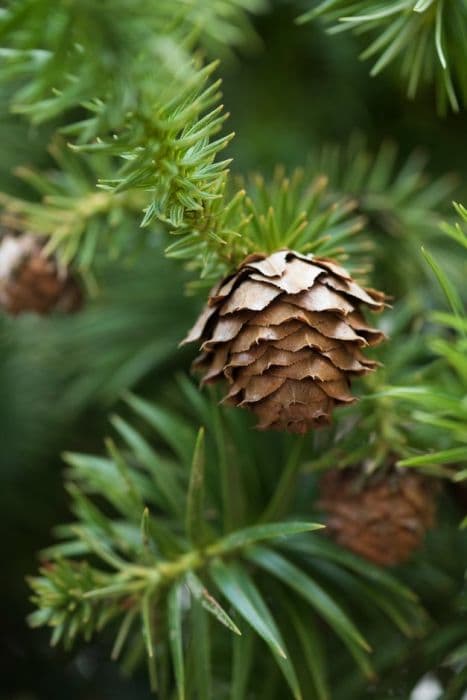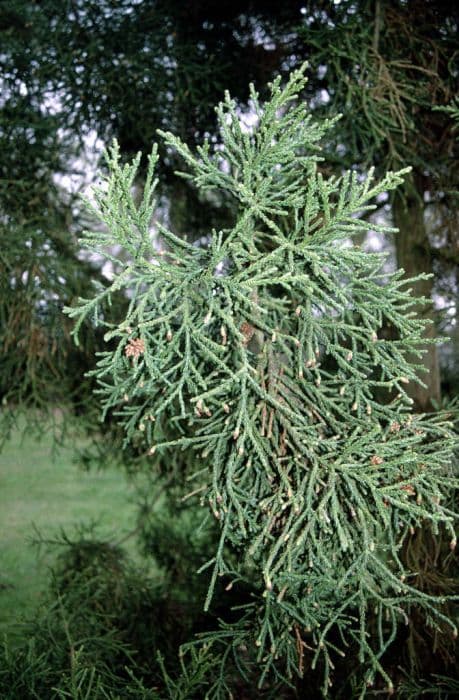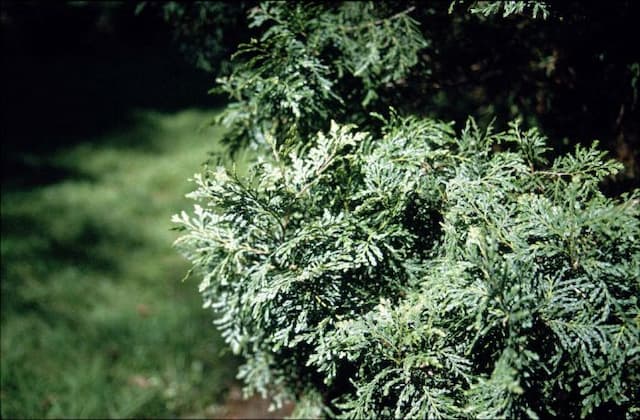Western Red Cedar Thuja plicata 'Atrovirens'

ABOUT
Thuja plicata 'Atrovirens', commonly known as the Western Red Cedar, is a visually striking evergreen conifer. This particular variety is noted for its dense, conical shape, which it maintains naturally without the need for meticulous pruning. The foliage of the Western Red Cedar 'Atrovirens' bears a rich, deep green color that remains vibrant throughout the year. The leaves are scale-like, overlapping tightly in a pattern that gives the branches a textured, braided appearance. The tree's foliage emits a pleasant, aromatic scent when crushed or brushed against, which is a characteristic feature of many cedar varieties. The Western Red Cedar 'Atrovirens' can also produce small cones, which are usually brown and approximately half an inch in length when mature. The bark of the tree is fibrous and reddish-brown, developing deep furrows and shredding in long vertical strips with age. Its overall appearance is one of lushness and vitality, making it a popular choice for landscaping purposes where the visual impact of a rich evergreen presence is desired.
About this plant
 Names
NamesFamily
Cupressaceae
Synonyms
Western Red Cedar, Giant Arborvitae, Pacific Redcedar, Shinglewood, Canoe Cedar
Common names
Thuja gigantea Nutt., Thuja lobbii Hutch., Thuja menziesii Douglas ex D. Don
 Toxicity
ToxicityTo humans
Western Red Cedar contains thujone, which can be toxic if ingested in large quantities. Though it is not commonly eaten due to its strong taste and fragrance, ingesting parts of the Western Red Cedar can lead to gastrointestinal upset, including nausea, vomiting, diarrhea, and abdominal pain. In severe cases, it might also result in muscle spasms, seizures, dizziness, and impaired consciousness. Prolonged exposure or large doses could result in organ damage or other serious health issues.
To pets
Western Red Cedar is also toxic to pets and can cause similar symptoms as seen in humans. If a pet ingests part of this plant, they may exhibit signs such as vomiting, diarrhea, drooling, abdominal pain, and potentially more severe reactions like muscle tremors or seizures. It is important to keep pets from chewing on or ingesting parts of this plant to avoid poisoning and the potential health complications that can follow.
 Characteristics
CharacteristicsLife cycle
Perennials
Foliage type
Evergreen
Color of leaves
Green
Height
20-70 feet (6-21 meters)
Spread
10-15 feet (3-4.5 meters)
Plant type
Tree
Hardiness zones
5-7
Native area
North America
Benefits
 General Benefits
General Benefits- Privacy Screening - Thuja plicata 'Atrovirens', commonly known as Western Red Cedar, is often used as a natural screen due to its dense foliage, providing privacy to gardens and outdoor spaces.
- Ornamental Appeal - With a uniform columnar shape and rich green foliage, this plant adds aesthetic appeal to landscapes year-round.
- Sound Barrier - The thick foliage can also act as a sound buffer, reducing ambient noise in urban or suburban settings.
- Windbreak - The dense growth habit makes it effective at protecting more vulnerable plants and areas from strong winds.
- Wildlife Habitat - Provides shelter and nesting sites for birds and other wildlife, enhancing biodiversity.
- Low Maintenance - Once established, Western Red Cedar requires minimal care, making it suitable for low-maintenance landscaping.
- Durable Wood - The wood of Thuja plicata 'Atrovirens' is naturally resistant to decay and rot, making it a good choice for outdoor construction.
- Evergreen Foliage - As an evergreen, it keeps its foliage throughout the year, keeping landscapes looking lively even in winter.
- Versatility - It can be used in various landscaping designs such as formal hedges, screens, or as a standalone specimen.
- Adaptability - Adapts well to a wide range of soil conditions and climates, making it suitable for many environments.
 Medical Properties
Medical PropertiesThis plant is not used for medical purposes.
 Air-purifying Qualities
Air-purifying QualitiesThis plant is not specifically known for air purifying qualities.
 Other Uses
Other Uses- Woodworking Projects: Western Red Cedar's lightweight and resistance to decay makes it an ideal choice for outdoor furniture, and it's also used in the production of certain musical instruments due to its acoustic properties.
- Boat Building: The rot-resistant wood of the Western Red Cedar is traditionally used for constructing small boats and canoes, admired for its buoyancy and workability.
- Crafts and Carving: The soft, straight-grained wood is favored for carved items, such as totem poles and ceremonial masks by indigenous peoples of the Pacific Northwest.
- Animal Bedding: Shavings of Western Red Cedar are used as bedding for small animals; its aromatic oils are thought to have natural flea-repelling properties.
- Landscape Design: Often used as a hedge or screen due to its dense, evergreen foliage, providing year-round privacy and sound abatement in garden settings.
- Aromatic Sachets: The aromatic wood chips and shavings can be used in sachets to impart a pleasant smell to closets and drawers and act as a natural moth deterrent.
- Insect Repellent: The essential oils derived from Western Red Cedar can be used as a natural insect repellent in certain eco-friendly products.
- Traditional Weaving: The inner bark can be processed and used in traditional basket weaving and fiber arts by indigenous communities.
- Culinary Smoking: Wood chips of the Western Red Cedar can impart a unique flavor when used for smoking meats and fish in culinary applications.
- Shingle and Roofing Material: Historically, the durable wood has been crafted into shingles for roofing, providing weather-resistant and insulating properties.
Interesting Facts
 Feng Shui
Feng ShuiThe Western Red Cedar is not used in Feng Shui practice.
 Zodiac Sign Compitability
Zodiac Sign CompitabilityThe Western Red Cedar is not used in astrology practice.
 Plant Symbolism
Plant Symbolism- Longevity: Thuja plicata 'Atrovirens', commonly known as the Western Red Cedar, is symbolic of longevity due to its potential to live for hundreds of years.
- Protection: With its evergreen foliage and strong wood, the Western Red Cedar represents safety and shelter, both physical and spiritual.
- Healing: Indigenous cultures have used parts of the Western Red Cedar tree for medicinal purposes, making it a symbol of health and healing.
- Purity: The tree's aromatic wood and resistance to decay are associated with purification and resilience against corruption or negativity.
 Water
WaterWestern Red Cedar prefers consistent moisture, especially during the first few growing seasons to establish a deep, extensive root system. Once established, it is more drought-tolerant. Water the plant deeply, applying around 1.5 gallons per tree each week during dry periods without rain. Adjust the amount based on rainfall, with less water needed during rainy seasons and more during dry spells. It's best to water this tree less frequently but thoroughly, rather than little and often, to ensure deep watering which encourages deeper root growth.
 Light
LightWestern Red Cedar thrives best in full sun to partial shade. It should be planted in a location where it can receive at least 4 hours of direct sunlight each day. However, the tree can also tolerate locations with filtered sunlight. Avoid deep shade, as this can impact its growth and overall health.
 Temperature
TemperatureThe Western Red Cedar can withstand quite a wide range of temperature conditions, making it adaptable to various climates. It can survive in temperatures as low as -20°F and as high as 80°F, though it prefers the cooler end of this spectrum. Ideal growing conditions are between 40°F and 70°F. It's cold hardy and can tolerate frost.
 Pruning
PruningPrune Western Red Cedar to maintain its shape and health. Pruning is best done in the late winter or early spring before new growth starts. It should be pruned lightly and not too often—typically once a year is sufficient. Remove any dead, damaged, or diseased branches, and trim to encourage the natural pyramidal shape if desired.
 Cleaning
CleaningAs needed
 Soil
SoilThe Western Red Cedar prefers a moist, well-draining soil mix rich in organic matter with a pH level of 6.0 to 7.5. A mixture of loam, peat, and some sand is ideal for ensuring proper drainage and fertility.
 Repotting
RepottingWestern Red Cedars seldom require repotting as they are typically grown outdoors; if grown in containers, repotting every 3 to 5 years is sufficient to refresh the soil and provide space for growth.
 Humidity & Misting
Humidity & MistingWestern Red Cedar thrives in moderate to high humidity levels but is quite adaptable and can tolerate a range of atmospheric moisture conditions.
 Suitable locations
Suitable locationsIndoor
Place in a bright spot, away from dry heat sources.
Outdoor
Plant in a sunny to partially shaded area with ample space.
Hardiness zone
5-7 USDA
 Life cycle
Life cycleWestern Red Cedar 'Atrovirens' begins its life cycle as a seed, typically germinating in moist, well-drained soils with partial to full sunlight exposure. Upon germination, the seedling stage is characterized by rapid root and shoot growth, with the first pair of true leaves developing. As the plant enters the juvenile phase, it develops its characteristic scale-like foliage and starts forming a conical shape. Reaching maturity after several years, it becomes a fully grown tree, capable of reaching heights of up to 70 feet or more, with a dense, pyramidal to conical form. During its reproductive stage, the Western Red Cedar produces small cones that mature in one season, containing seeds that disperse through the wind. In optimal conditions, the tree can live for several hundred years, completing its life cycle before eventually succumbing to age or environmental factors.
 Propogation
PropogationPropogation time
Spring-Early Summer
The Western Red Cedar, scientifically known as Thuja plicata 'Atrovirens', is typically propagated from semi-hardwood cuttings. This method is most popular due to its simplicity and high success rate. The optimal time for taking cuttings is during late summer or early fall, just before the onset of dormancy when the current year's growth has matured. To propagate, cuttings of about 4 to 6 inches (10 to 15 centimeters) are taken from healthy, disease-free parent plants. The lower third of the cutting should be stripped of foliage, and a rooting hormone is often applied to the cut end to encourage root development. The prepared cutting is then inserted into a moist potting mix and kept under high humidity and indirect light until roots have established, which typically takes a few weeks to a few months depending on environmental conditions.









